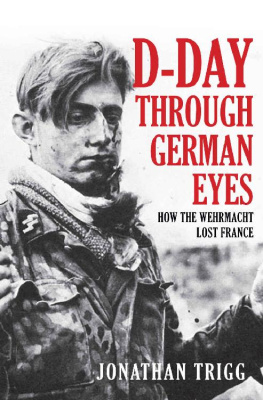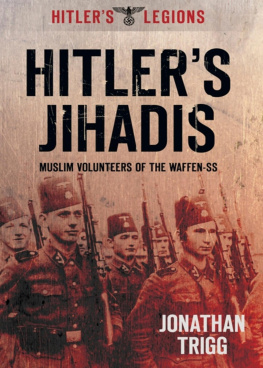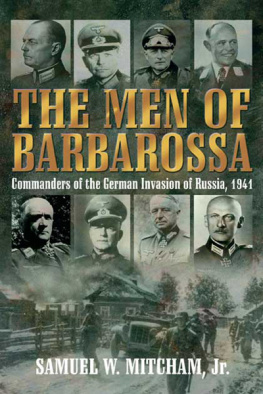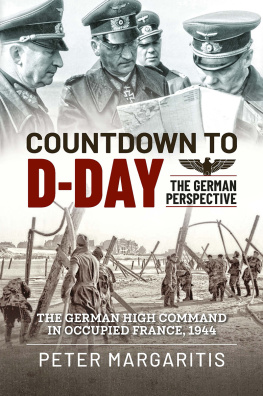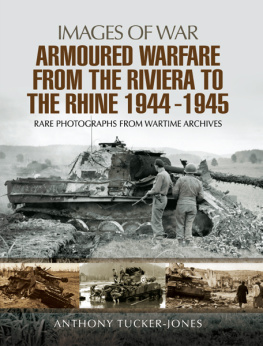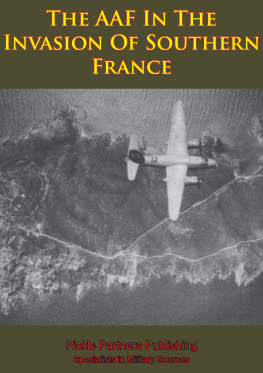


Other books by the author
Hitlers Legions series
Hitlers Gauls The History of the French Waffen-SS
Hitlers Flemish Lions The History of the Flemish Waffen-SS
Hitlers Jihadis The History of the Muslim Waffen-SS
Hitlers Vikings The History of the Scandinavian Waffen-SS
Hastings 1066
Death on the Don The Destruction of Germanys Allies on the Eastern Front 1941 (nominated for the Pushkin Prize for Russian history)
The Defeat of the Luftwaffe The Eastern Front 1941 45; Strategy for Disaster
Voices of the Flemish Waffen-SS: The Last Testament of the Oostfronters
Voices of the Scandinavian Waffen-SS: The Last Testament of Hitlers Vikings
Page 1 : The Atlantikwall of legend this is one of four giant 380mm guns of the Batterie Todt in the hamlet of Haringzelle near Cap Gris Nez all were capable of hitting the English coast. (Library of Congress)
Page 2 : One of Max Wnsches Panthers knocked out by Canadians in Bretteville lOrgueilleuse on 8 June 1944. (Authors collection)
First published 2019
Amberley Publishing
The Hill, Stroud
Gloucestershire, GL5 4EP
www.amberley-books.com
Copyright Jonathan Trigg, 2019
The right of Jonathan Trigg to be identified as the Author of this work has been asserted in accordance with the Copyrights, Designs and Patents Act 1988.
All rights reserved. No part of this book may be reprinted or reproduced or utilised in any form or by any electronic, mechanical or other means, now known or hereafter invented, including photocopying and recording, or in any information storage or retrieval system, without the permission in writing from the Publishers.
British Library Cataloguing in Publication Data.
A catalogue record for this book is available from the British Library.
ISBN 9781445689319 (HARDBACK)
ISBN 9781445689326 (eBOOK)
Typesetting by Aura Technology and Software Services, India.
Printed in the UK.
Contents
This book is dedicated to two very special people; to John Andrzejowksi for saving my life, and to Peena for making it worth saving.
Acknowledgements
This book has been published to coincide with the 75th anniversary of the D-Day landings and the subsequent battle for France waged that same summer. It is a truly enormous subject, encompassing the largest amphibious invasion ever undertaken, and an ensuing campaign that involved more than two million men and an unfathomable amount of equipment, supplies and machinery.
The challenge I set myself with this book was to boil this enormous clash of arms down to the view from the trenches, as it were. As ever, my editor Shaun Barrington has been nothing but supportive in this effort and I offer him my thanks for that. I would also like to pay tribute to those who have gone before me; authors such as Holger Eckhertz, Bruce Connor, Vince Milano and Richard Hargreaves, who have done incredible work to tell the story of the humble landser , before they are all gone. A book with a focus on witness testimony wouldnt be able to be written without witnesses, and to the veterans who have been so generous with their time and memories, particularly Rudolf von Ribbentrop, thank you.
One regret I have had in writing this book is not to have included enough about the Allied landings in southern France in August 1944 and the subsequent running battle with Johannes Blaskowitzs army group for that I apologise, I think it is a segment of the European war which is relatively unknown, and worthy of much more time and work than has hitherto been devoted to it.
Researching and writing any book can be a solitary task, and often an obsession and this one has proven to be no different. Endless trips to view archives, interview veterans, added to hours of telephone calls, snatched meals and a grumpy demeanour, can put a huge strain on any family, but as ever my own has exhibited a deep well of understanding and affection for which I am forever grateful; to my amazing wife Rachel and our wonderful children, Maddy, Jack, thank you.
Notes on the text
The United Kingdom contains Scots, Welsh and Northern Irish, but the Germans tended to describe everyone from our islands as English , so I have left it at that. The same goes for the former Soviet Union, if a veteran has used the term Russian, then I have kept it as such. I have tended to use the German nomenclature for their units, e.g. the 352nd Infantry Division is written as 352. ID , short for 352. Infanterie-Division , and German ranks are likewise; Captain is Hauptmann etc; there is a table of comparative ranks as an appendix.
Every effort has been made to cite sources and contact copyright holders. If there are any omissions I apologise and the publishers will correct on reprint. As ever in any such work there are bound to be errors, they are all my own and I ask the readers forbearance.
Introduction
A 53-year-old Texan chain-smoker of average height, with a dodgy knee and a love of Western novels especially those by Zane Grey, a part-time dentist-cum author was pacing up and down the thick carpet of a large room in the Georgian splendour of Southwick House, some five miles north of Portsmouth on the English south coast. Outside, rain was lashing down onto the roof and strong winds were rattling the black-out shutters, but inside, the silence was total. Seated a few feet away from the pacing man were half a dozen of the most senior officers in the Anglo-American military, all of them bar one in full uniform, heavy with their decoration ribbons; their shoes highly polished, their trousers knife-edged. Behind them was a gaggle of aides and middle-ranking officers standing to one side a tall, thin, lowland Scot in the blue of the British Royal Air Force, papers and charts gripped in his large, bony hands. Suddenly the pacer popularly known to one and all as Ike stopped, looked up from the carpet to his seated audience, and said three words: Okay, lets go.
Twenty-four hours later, and about eight hundred miles away as the crow flies, it was still dark in the Bavarian Alps. The air was still, the only sound that of jackboots crunching on gravel, as the bored sentries almost all of whom were immensely tall, blond-haired and blue-eyed did their usual rounds of the jumble of lodges, tea-houses and holiday villas. In the chalet-style house at the epicentre of the whole smorgasbord of newly built luxury buildings, all was quiet, the staff having finished clearing up the glasses and tableware from the dining room and study panelled in Swiss pine, where just a few hours before their master and some of his closest confidants had been sat round an open fire reminiscing about the good old days. One of the last to leave in the early hours had been Joseph Goebbels, a diminutive Westphalian with a pronounced limp and holder of the Third Reichs post of Minister for Propaganda. Oddly enough, the pacing smoker and the disabled propagandist were both of mixed German-Dutch heritage, but there, any similarity ended. The former was a modest man, one of the greatest military coalition commanders the world has ever seen, who would go on to become the 34th President of his country, whereas the latter was a womanising, virulent anti-Semite, who would end up foully murdering his six young children before taking his own life.
This then was how D-Day started for both sides; for the Anglo-Americans with a considered decision taken by their senior military commanders led by the U.S. General Dwight David Eisenhower and for the Germans with their entire leadership asleep, oblivious, and in the dark.
Next page
